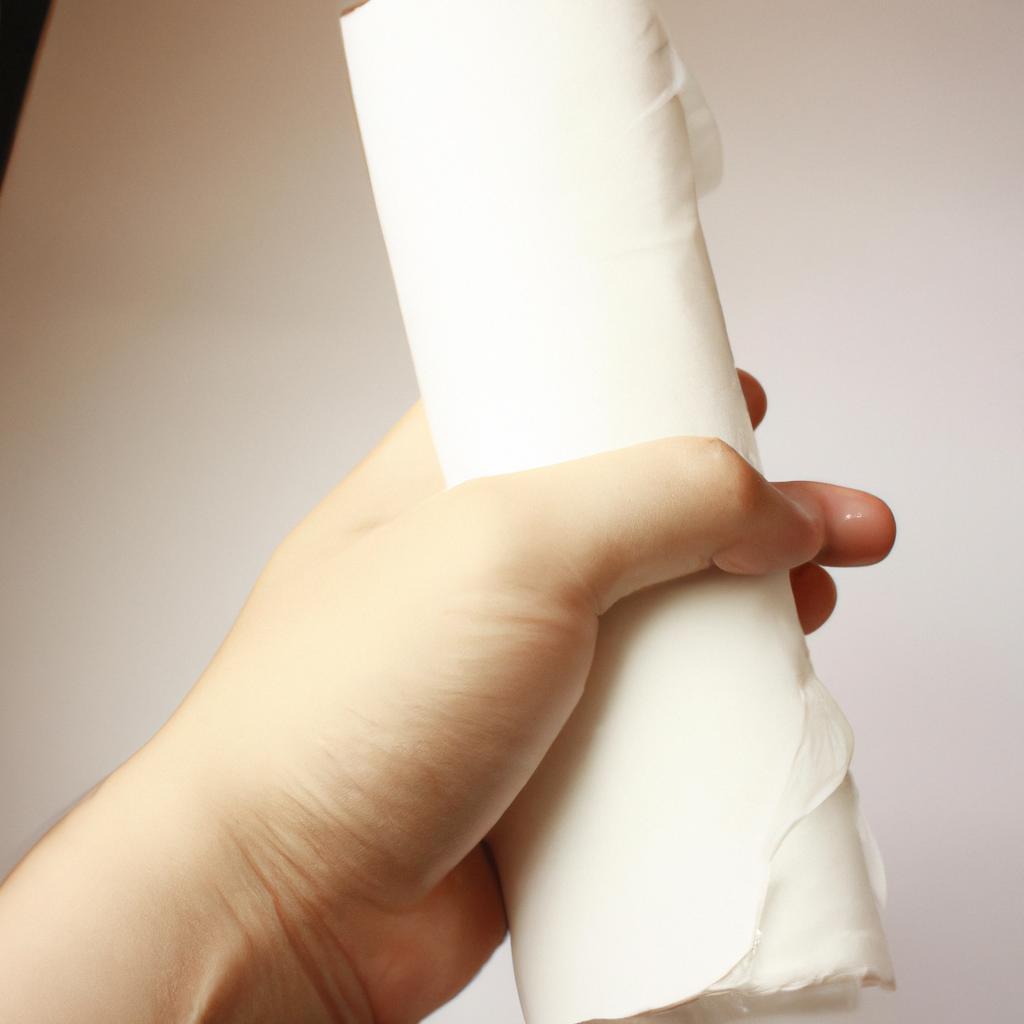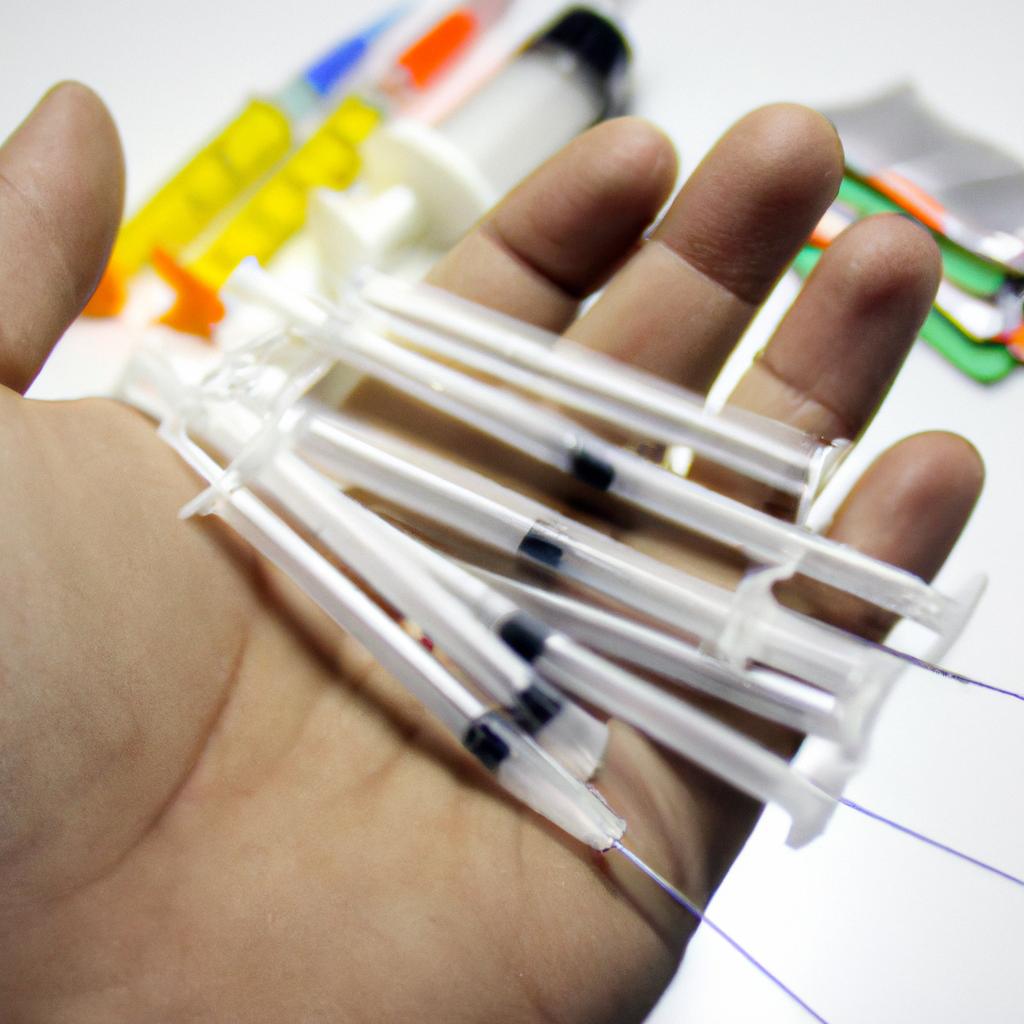Gauze is a widely used and essential material in the field of healthcare. It serves multiple purposes, including wound dressing, cleaning, and protection against contamination. This article aims to provide comprehensive information about gauze as an indispensable tool for disposable instruments and supplies.
In one hypothetical scenario, imagine a patient who has undergone surgery and requires post-operative care. The surgeon carefully applies sterile gauze over the incision site to absorb any excess fluids or blood, preventing infection and promoting healing. Gauze plays a vital role in providing a protective barrier between the surgical wound and external contaminants, minimizing the risk of complications.
Understanding the various types of gauze available is crucial for healthcare professionals. From woven to non-woven fabric options, each type possesses unique characteristics that determine its suitability for specific applications. Additionally, knowledge about different sizes, thicknesses, and sterility levels ensures appropriate selection based on individual patient needs. By delving into the composition, manufacturing process, and proper usage guidelines of gauze products, this article aims to equip readers with essential information necessary for effective utilization of these disposable instruments and supplies in medical settings.
What is gauze and its primary uses?
Picture a scenario: A young girl falls off her bike and scrapes her knee. Her concerned mother rushes to her aid, grabbing a roll of gauze from the first-aid kit. Gently, she cleans the wound with antiseptic before wrapping it in layers of soft, absorbent gauze. In this case, gauze serves as an indispensable tool for caring for wounds, but what exactly is it and how does it fulfill its purpose?
Gauze refers to a thin, loosely woven fabric made primarily from cotton or synthetic fibers such as polyester. Its open mesh structure allows air circulation while providing excellent absorption properties. This versatile material finds extensive applications not only in healthcare settings but also in various industries including personal care, cleaning, and food preparation.
The primary uses of gauze can be summarized as follows:
- Wound dressing: Gauze is commonly used to cover and protect wounds by absorbing excess fluid and preventing contamination.
- Cleaning and sterilization: It proves useful in cleaning delicate surfaces due to its non-abrasive nature.
- Applying medication: Gauze acts as a carrier for topical medications when applied directly to affected areas.
- Surgical procedures: Surgeons employ sterile gauze during surgeries to control bleeding or isolate organs.
To illustrate further, consider the following examples that demonstrate the significance of gauze across different domains:
| Domain | Example |
|---|---|
| Healthcare | Surgical dressings |
| Personal care | Makeup removal |
| Cleaning | Polishing glass |
| Food industry | Straining liquids |
In summary, gauze plays an essential role in our daily lives by serving multiple purposes ranging from wound management to industrial applications. Understanding its characteristics and different types will provide us with valuable insights into choosing appropriate materials for specific needs. Thus, let us now explore the various types of gauze and delve into their unique characteristics.
Different types of gauze and their characteristics
Section H2: Different types of gauze and their characteristics
Transitioning from the previous section on the primary uses of gauze, it is important to explore the different types of gauze available in order to understand their unique characteristics and applications. One example that highlights the importance of choosing the right type of gauze involves a hypothetical scenario where a healthcare professional needs to dress a deep wound with excessive bleeding. In this case, using an absorbent and non-adherent type of gauze would be ideal as it allows for effective absorption without sticking to the wound.
To further illustrate the variety within this essential medical supply, here are some commonly used types of gauze along with their key features:
-
Woven Gauze:
- Made from cotton or synthetic fibers woven together.
- Provides excellent strength and durability.
- Suitable for general wound care purposes.
- Can be used for cleaning wounds or applying ointments.
-
Non-Woven Gauze:
- Created by bonding fibers together mechanically or chemically.
- Offers superior softness and comfort.
- Ideal for delicate skin or sensitive areas.
- Often utilized in cosmetic procedures or facial treatments.
-
Sterile Gauze:
- Manufactured under strict sterile conditions.
- Ensures a clean environment during wound dressing.
- Minimizes risks of infection and cross-contamination.
- Essential for surgical procedures or open wounds.
-
Impregnated Gauze:
- Infused with antimicrobial agents like iodine or silver nitrate.
- Helps prevent infections and promote healing.
- Particularly useful in managing infected wounds or chronic ulcers.
The diversity among these various types of gauze underscores the importance of selecting the appropriate one based on specific requirements such as wound depth, sensitivity, sterilization needs, and desired therapeutic properties.
In our next section, we will delve into the proper techniques for using and applying gauze to ensure optimal wound care. Understanding these guidelines is crucial in order to maximize the benefits of this versatile medical supply and promote effective healing.
Transitioning into the subsequent section about “How to properly use and apply gauze,” it is essential to acquire a comprehensive understanding of best practices surrounding gauze application.
How to properly use and apply gauze
Different types of gauze have varying characteristics that make them suitable for specific medical situations. Understanding these differences is essential to ensure the proper use and application of gauze in healthcare settings. For instance, let’s consider a hypothetical scenario where a patient has suffered a deep laceration on their arm.
When choosing the appropriate type of gauze for this wound, several factors should be taken into account:
-
Absorbency: The ability of gauze to absorb fluids plays a crucial role in wound management. Highly absorbent gauze is ideal for wounds with heavy bleeding or excessive exudate. In our example, a highly absorbent gauze would help control any bleeding from the patient’s laceration effectively.
-
Sterility: Maintaining sterility is paramount when dealing with open wounds to prevent infection. When selecting gauze, it is important to choose sterile options that are individually packaged or come from sealed containers. This ensures the integrity of the product and reduces the risk of contamination during dressing changes.
-
Conformability: Gauze should be able to conform well to different body contours and wound shapes without restricting movement or causing discomfort. It should also provide an adequate barrier against external contaminants while allowing oxygen exchange for optimal wound healing.
-
Non-Adherence: Some types of gauze have special coatings or finishes that prevent sticking to the wound bed, minimizing trauma during removal and reducing pain experienced by patients during dressing changes.
To better understand how various types of gauze differ in terms of these characteristics, refer to the following table:
| Type | Absorbency | Sterility | Conformability | Non-Adherence |
|---|---|---|---|---|
| Cotton | High | Yes | Good | No |
| Non-Woven | Medium-High | Yes | Excellent | Yes |
| Gauze Sponges | High | Yes | Good | No |
| Alginate | Very high | Yes | Fair | Yes |
By considering these factors and understanding the unique characteristics of each type of gauze, healthcare professionals can make informed decisions when selecting the most suitable option for specific wound care requirements.
Moving forward to the next section about important factors to consider when choosing gauze, it is crucial to evaluate additional aspects that go beyond the physical properties discussed here. This will ensure comprehensive knowledge in making effective choices regarding disposable instruments and supplies used in medical settings.
Important factors to consider when choosing gauze
In a hospital setting, proper usage and application of gauze is crucial for effective wound care. Let us consider the case of a patient with a deep laceration on their forearm. The attending physician decides to clean the wound thoroughly before applying a sterile dressing. Here are some essential steps to follow when using and applying gauze:
-
Cleaning the wound: Before applying gauze, it is vital to clean the wound site properly. This can be done by gently irrigating the area with a saline solution or an antiseptic solution recommended by healthcare professionals.
-
Choosing the appropriate size: Gauze comes in various sizes, so selecting the right dimensions according to the wound’s requirements is important. In this case, the physician chooses 4×4 inch sterile gauze pads that adequately cover the laceration.
-
Applying pressure: Once the wound has been cleaned, firm but gentle pressure should be applied with dry gauze to stop any bleeding. Maintaining continuous pressure for several minutes helps promote clot formation and minimize further blood loss.
-
Securing with tape or bandage: After bleeding has stopped, securing the gauze pad in place becomes necessary to protect the wound from external contaminants while promoting healing. Using adhesive medical tape or an elastic bandage ensures proper fixation without compromising comfort.
Now let’s explore some important factors to consider when choosing gauze:
- Absorbency: Gauze varies in its absorbent properties; some types are designed specifically for heavy exudate while others are more suitable for light drainage.
- Sterility: Ensuring that your chosen gauze is sterile plays a critical role in preventing infections at wound sites.
- Material composition: Gauzes made from natural fibers like cotton offer good breathability, reducing moisture retention and enhancing healing conditions.
- Non-stick coating: Some gauze pads come with a non-stick coating, which prevents the dressing from sticking to the wound and causing discomfort during removal.
To summarize, proper usage of gauze involves cleaning the wound, selecting an appropriate size, applying pressure to stop bleeding, and securing it in place. When choosing gauze for any medical procedure or wound care, factors such as absorbency, sterility, material composition, and non-stick coatings should be considered.
Proper storage and handling of gauze
Transitioning from the previous section on important factors to consider when choosing gauze, let us now delve into the proper storage and handling of this essential medical supply. To illustrate its significance, imagine a scenario where a healthcare facility fails to store gauze properly. Over time, due to exposure to moisture or inadequate protection from external contaminants, the gauze becomes compromised and loses its integrity. Consequently, when used during procedures such as wound dressings or surgeries, it fails to provide the necessary sterile environment for healing, potentially leading to infections or complications.
Proper storage and handling of gauze are crucial in maintaining its effectiveness and minimizing potential risks. Consider the following guidelines:
-
Storage conditions: Gauze should be stored in clean, dry areas away from direct sunlight and sources of moisture. Exposure to excessive humidity can lead to mold growth or degradation of the fabric’s structure.
-
Packaging integrity: When storing gauze, ensure that its original packaging is intact and undamaged. If any signs of tampering or compromise are detected, it is advisable to discard the product immediately.
-
First-in-first-out (FIFO): Adhering to FIFO principles ensures that older stock is used first before newer supplies. This practice helps prevent expiration of unused gauze rolls or pads while ensuring fresh stock is always available.
-
Contamination prevention: Gauze should be handled with clean hands using appropriate personal protective equipment (PPE), such as gloves. Avoid touching unused portions directly by using forceps or other sterile instruments.
- Proper storage protects patients from potential infections.
- Inadequate handling compromises patient safety.
- Negligence in these aspects puts both healthcare professionals and patients at risk.
- Strict adherence minimizes wastage and promotes cost-effectiveness.
Additionally, visualizing information can enhance understanding and engagement. Take a look at the following table, which summarizes key considerations for gauze storage:
| Consideration | Importance |
|---|---|
| Storage temperature | High |
| Protection from moisture | High |
| Packaging integrity | Medium |
| Contamination prevention | High |
By paying attention to these factors and guidelines, healthcare facilities can ensure that their gauze supplies remain effective and safe for use in diverse medical procedures.
In transitioning to the subsequent section on common mistakes to avoid when using gauze, it is essential to highlight the significance of proper usage without explicitly stating “step.” By focusing on avoiding errors, we can further promote patient safety and optimize the benefits of utilizing this crucial medical supply.
Common mistakes to avoid when using gauze
Section H2: Common mistakes to avoid when using gauze
Having discussed the proper storage and handling of gauze in the previous section, it is crucial to be aware of common mistakes that should be avoided when using this essential medical supply. By understanding these errors, healthcare professionals can ensure optimal patient outcomes and prevent any potential complications. Additionally, learning from real-life scenarios can help illustrate the importance of avoiding these mistakes.
Example: For instance, imagine a scenario where a nurse applying gauze compresses fails to remove all packaging materials before use. As a result, small particles become embedded within the wound site, leading to delayed healing and an increased risk of infection. This highlights the significance of being meticulous during the application process while also emphasizing the need for awareness regarding common pitfalls associated with gauze usage.
- Failure to properly clean and disinfect wounds before applying gauze
- Using expired or damaged gauze products
- Applying excessive pressure while dressing wounds with gauze
- Neglecting to monitor the condition of the wound after applying gauze
Table (3 columns x 4 rows):
| Mistake | Consequence | Prevention |
|---|---|---|
| Improper cleaning | Increased risk of infection | Thoroughly cleanse wounds before applying gauze |
| Expired or damaged gauze | Ineffective wound care | Regularly check expiration dates and inspect packages |
| Excessive pressure | Discomfort for patients | Use gentle but firm pressure on wound dressings |
| Lack of monitoring | Delayed identification of complications | Routinely assess and change dressings as necessary |
In summary, avoiding common mistakes when utilizing gauze is paramount in providing quality patient care. The example illustrated how neglecting proper removal of packaging materials could lead to adverse outcomes. To prevent such errors, healthcare professionals should be cautious during wound dressing and ensure thorough cleaning, use only valid and intact gauze products, apply appropriate pressure, and consistently monitor the condition of wounds after applying gauze.
(Note: The markdown formatting for tables may not display correctly in this plain text format. When using the provided content in a markdown editor or platform that supports tables, it will render as intended.)




